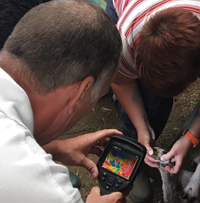
Posted to News on 1st Dec 2019, 00:00
Increasing sheep welfare with thermal imaging
When something isn’t working optimally, excess heat is commonly a tell-tale sign. This simple fact has led thermal imaging to become an important inspection tool in many industries including dairy farming.

The National Animal Disease Information Service (NADIS) reports the cost of mastitis to farmers is between £70 and £250 per cow per annum. Thermal imaging is proving highly effective in automated milking parlours for the early detection of mastitis in cows and providing cost savings to farmers. Indeed, the ability of a thermal camera to ‘see’ inflammation in this way is being considered for detection of other diseases in farmed animals such as sheep.
Ongoing university research is evaluating the use of thermal imaging to address lameness in sheep. Aside from the welfare concern, lameness causes significant financial loss. According to NADIS, the problem currently costs UK farmers £28m per annum. The main cause of lameness is a bacterial hoof infection and early detection is not only essential to lessening the severity of the symptoms and other health issues, but also to preventing its spread throughout the flock.
To manage and minimise the problem, farmers routinely gather and pen their sheep to examine their hooves. Those showing signs of lameness are then separated and treated appropriately. This is both a time-consuming task and one that can be distressing for the animals.
To find a solution the university is working with Stanbury’s, a company that primarily specialises in building surveying and estate management. Thermal imaging is vital to its efficient diagnosis of faults in building fabric. This experience has led the company to diversify into the provision of thermography services and Flir infrared camera sales in other industries.
“A thermal imaging camera is designed to detect infrared energy and build a picture based on the different temperatures emitted by the target,” explained Allister Pirrie, a level 2 thermographer with Stanbury’s. “It is a non-contact technology that can be used effectively over distance and has great potential in farming applications.”
To measure temperature accurately over distance depends on several factors with two of the most important being the resolution of the detector and the chosen camera lens. Stanbury’s therefore recommended the Flir E85 for the sheep foot-rot detection research.
The Flir E85 is a hand-held thermal imaging camera with intelligent interchangeable lenses, laser-assisted autofocus modes and area measurement functionality. The company’s patented MSX image enhancement technology is standard on the Flir E85 as it includes UltraMax, an embedded super-resolution process that improves effective resolution by four times and thermal sensitivity by up to 50%.
Pirrie concluded: “Initial trials have gone brilliantly. The FLIR E85 has consistently provided fast and effective spot diagnosis of sheep while they are grazing in the field. This allows the vet to spot trauma at a distance and localise an individual for examination and as it is a non-invasive and non-contact method, there is no distress to the animal.”
Trials are on-going and it has already become evident that the benefits of thermal imaging could extend beyond initial diagnosis of foot disease. The Flir E85 is now also being evaluated as a non-invasive method for observing how sheep are responding to treatment for injuries and disease. This means that the animals do not have to be penned, enhancing their welfare and saving farmers costs.






